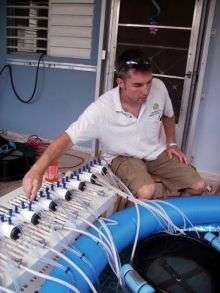Smithsonian scientists working to save microscopic threatened species

The Smithsonian’s National Zoo recently acquired 12,000 new animals—microscopic Elkhorn coral larvae harvested by National Zoo scientists in Puerto Rico—as part of an international collaborative program to raise the threatened species. National Zoo scientists hope to one day return the animals, once they are grown, to their wild ocean habitat.
In August, Zoo Reproductive Scientist Dr. Mary Hagedorn and Invertebrates Keeper Mike Henley traveled to Puerto Rico with marine scientists involved with SECORE (SExual COral REproduction) to collect and artificially inseminate coral. Hagedorn is pioneering the cyropreservation (freezing, storing and thawing) of coral sperm and eggs. Working in collaboration with SECORE, she is trying to create a genome resource bank, which will help preserve the genetic diversity of coral.
Hagedorn, Henley and the team captured spawning coral gametes in nets during night dives and transferred them back to their laboratory on the beach for research and artificial insemination—often working until 3 a.m. Using 75 feet of specially designed flexible PVC piping that could be bent around the coral so as not to harm it, the team created a water-flow system that allowed water from the ocean to continuously flow in and out of the coral larvae enclosure located in the beachfront laboratory. Keeping the water fresh and at a constant temperature is essential for corals that flourish in stable environments.
“Conservation of a delicate underwater species is always a challenge,” said Hagedorn, “We achieved some important milestones this year, including learning more about the larvae rearing process, and we were able to cryopreserve the endangered coral sperm. Given more research, this technique may become instrumental in helping re-establish healthy coral populations in the Caribbean.”
Meanwhile, at the Zoo’s Invertebrates Exhibit, keeper Mike Henley has been coaxing the 12,000 coral larvae to settle in a specially designed tank. The 90-gallon, salt-water tank features high-wattage lights and a custom-built surge device that mimics the movement of the surf in the coral’s native Caribbean habitat.
From the original 12,000, 158 larvae settled onto specially designed tiles and formed polyps—millimeter-sized corals that could eventually grow to be 10 feet wide. Henley will continue to count the coral throughout the next few months. The small percentage of coral that takes hold as a polyp underscores the difficult and delicate task of rearing a fragile species in captivity.
“We hope we can establish a captive population of Elkhorn that can be reintroduced to the wild,” said Henley. “If this year’s collection does not meet the criteria, hopefully future SECORE ‘recruits’ will yield possible candidates.”
Coral reefs are dying from causes largely due to human influences. In the Caribbean populations of the massive Elkhorn coral (Acropora palmate), which historically have been the primary and most ecologically important reef-building coral, have declined from 90 to 99 percent since the mid 1980s. As a result, it is one of the first corals listed as “threatened” under the Endangered Species Act.
As many aquarium enthusiasts already know, coral can be easily reared in captivity—new colonies can grow from broken fragments of parent colonies. Those new colonies, however, are clones with the same genetic makeup as the parent coral.
For this reason, the National Zoo’s work with the artificial insemination and captive breeding of coral as a member of SECORE is essential to fighting its extinction. Genetic diversity is key in any species bred for eventual release into the wild. The more genetically diverse a population, the greater its chance of surviving various environmental stresses.
Source: Smithsonian















